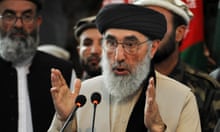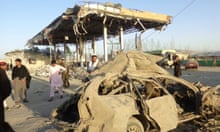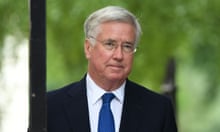Up to 36 suspected Islamic State militants were killed in Afghanistan when the US dropped the largest non-nuclear bomb ever used in combat, the Afghan defence ministry said on Friday.
To target what the military described as a “tunnel complex” used by the Isis’s Afghanistan affiliate, the US for the first time used what the military colloquially calls the “mother of all bombs”, the GBU-43/B.
Dawlat Waziri, an Afghan ministry spokesman said of Thursday’s strike: “No civilian has been hurt and only the base, which Daesh used to launch attacks in other parts of the province, was destroyed.”
Designed for destroying underground targets but not itself a deep-earth penetrator weapon, the GBU-43/B has the explosive yield of more than 11 tons of TNT. The massive bomb is dropped from air force planes and detonates before reaching the ground, resulting in an enormous blast radius. Only the Massive Ordnance Penetrator GBU-57, which has never been used in war, is a larger conventional weapon.
The psychological effect on survivors or observers is considered an added impact of the weapon.
Asked whether he had authorized the bombing, Donald Trump said: “Everybody knows exactly what happened. What I do is I authorize my military. We have the greatest military in the world and they’ve done a job as usual. We have given them total authorization and that’s what they’re doing and frankly that’s why they’ve been so successful lately.”
Did this bombing send a message to North Korea? “I don’t know if this sends a message; it doesn’t make any difference if it does or not,” the president said. “North Korea is a problem, the problem will be taken care of.” He implied that China was “working very hard” on this issue.
Army Gen John W Nicholson, the commander of US forces in Afghanistan, said in a statement that the GBU-43/B was the “right munition” to use against the Islamic State in Khorosan, or Isis-K.
“As Isis-K’s losses have mounted, they are using IEDs, bunkers and tunnels to thicken their defense. This is the right munition to reduce these obstacles and maintain the momentum of our offensive against Isis-K,” Nicholson said.
The blast detonated at 7.32pm local time in the Achin district of the eastern province of Nangarhar, according to the US military.
Sarab, a local resident from Asadkhel in Achin, close to the mountain where the bomb targeted Isis tunnels, said he saw a giant flame before the blast made the ground shake. “It was the biggest blast I have ever heard,” he said. Sarab added that the targeted area had recently been completely occupied by Isis fighters.
“There is no way that civilians were still living there,” he said.
However, a parliamentarian from Nangarhar, Esmatullah Shinwari, said locals had told him one teacher and his young son had been killed. One man, the MP recounted, had told him before the phone lines went down: “I have grown up in the war, and I have heard different kinds of explosions through 30 years: suicide attacks, earthquakes different kinds of blasts. I have never heard anything like this.” Phone connections are regularly interrupted in Achin and there were no immediate indication of casualties.
Haji Ghalib Mujahed, a local veteran commander, said he felt “tremors” all the way to Bati Kot, a neighbouring district where he is now the administrative chief.
According to the most recent estimates from the US military in Afghanistan, there are between 600 and 800 Isis-K fighters in the country. Most of them are based in southern Nangarhar province, including in Achin.
An American special forces soldier was killed last week in Achin while fighting Isis-K, but a US military spokesman in Kabul, Capt William Salvin, said there was “absolutely no connection” between that death and Thursday’s bombing.
Nicholson’s command said it took “every precaution to avoid civilian casualties”, without defining those steps, but gave no word on the impact to Afghan civilians.
The military said it used the GBU-43/B to “minimize the risk” to Afghan and US forces fighting Isis-K in Achin.
Following the bombing, US and Afghan forces began clearing operations in the targeted area.
An Afghan army soldier told the Guardian, as he was driving toward the targeted area: “The explosion felt like a big earthquake, even in the surrounding districts.”
Trump has said practically nothing about Afghanistan, either as candidate or president. Nicholson told Congress in February that he wanted a few thousand more troops to bolster the 8,400-strong force Barack Obama left to wage America’s longest war, now in its 16th year.
Trump on Wednesday said he would dispatch his national security adviser, HR McMaster, to meet with Nicholson and conduct a policy review. As a three-star army general on active duty, McMaster is outranked by Nicholson, making it difficult for McMaster to resist Nicholson’s recommendations.
The US military is currently facing widespread concerns that its accelerated bombing campaigns in Syria, Iraq and Yemen are increasing civilian casualties. A 17 March strike on a building in Mosul is currently under investigation after killing scores of Iraqis.
US allies have also felt the brunt of escalated US airstrikes. On Thursday, the Pentagon revealed that its Syrian allies in a Kurdish-led ground force, the Syrian Democratic Forces, requested an airstrike on an errant position erroneously believed to be held by Isis. The 11 April strike killed 18 fighters belonging to the Syrian Democratic Forces themselves.
Air Force statistics released on Thursday show that March 2017 was the most intense month of the US-led bombing campaign against Isis in Iraq and Syria, a war nearly three years old. US warplanes fired 3,878 munitions in March, topping January 2017’s previous high of 3,600.
In Afghanistan, US warplanes fired 203 weapons in March, the highest volume since October.
Hamid Karzai, the former president of Afghanistan installed in 2001 by the US and backed by the international community, tweeted that the bombing meant Afghans needed to “stop the USA”.
Trump said on the campaign trail that he would “bomb the shit” out of Isis.
His spokesman, Sean Spicer, said on Thursday the use of the GBU-43/B showed the US “takes the fight against Isis very seriously and in order to defeat the group we must deny them operational space, which we did ”.
Describing the bombing at his regular White House press briefing, he told reporters: “At around 7pm local time in Afghanistan last night the United States military used a GBU-43 weapon in Afghanistan. The GBU-43 is a large, powerful and accurately delivered weapon. We targeted a system of tunnels and caves that Isis fighters used to move around freely, making it easier for them to target US military advisers and Afghan forces in the area.”
He refused to answer further questions about the bomb at his regular press briefing, referring journalists to the Department of Defense.
Additional reporting by David Smith in Washington








